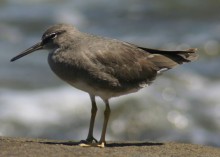Identifying waders is broken into two sections, one covering the regularly seen Australian species and another section covering the rarer and vagrant species.
We will be adding to this section as time goes by so come back or check the “What’s New” section. You can select a species account from the web site menu or by clicking on the species in the list below
The waders covered in the sections are:
Waders regularly seen in Australia
- Asian Dowitcher
- Australian Pratincole
- Banded Lapwing
- Banded Stilt
- Bar-tailed Godwit
- Beach Stone-curlew
- Black-fronted Plover
- Black-tailed Godwit
- Black-winged Stilt
- Broad-billed Sandpiper
- Bush Stone-curlew
- Common Sandpiper
- Curlew Sandpiper
- Double-banded Plover
- Eastern Curlew
- Great Knot
- Greater Sandplover
- Greenshank
- Grey Plover
- Grey-tailed Tattler
- Hooded Plover
- Inland Plover
- Latham’s Snipe
- Lesser Sandplover
- Little Curlew
- Marsh Sandpiper
- Masked Lapwing
- Oriental Pratincole
- Oriental Plover
- Pacific Golden Plover
- Painted Snipe
- Pied Oystercatcher
- Red Knot
- Red-capped Plover
- Red-kneed Dotterel
- Red-necked Avocet
- Red-necked Stint
- Ruddy Turnstone
- Sanderling
- Sharp-tailed Sandpiper
- Sooty Oystercatcher
- Terek Sandpiper
- Wandering Tattler
- Whimbrel
- Wood Sandpiper
Waders rarely seen in Australia
- Baird’s Sandpiper
- Buff-breasted Sandpiper
- Caspian Plover
- Cox’s Sandpiper
- Dunlin
- Eurasian Curlew
- Green Sandpiper
- Grey Phalarope
- Hudsonian Godwit
- Lesser Yellowlegs
- Little Ringed Plover
- Little Stint
- Long-toed Stint
- Pectoral Sandpiper
- Pin-tailed Snipe
- Redshank
- Red-necked Phalarope
- Ringed Plover
- Ruff
- Short-billed Dowicher
- Spotted Greenshank
- Stilt Sandpiper
- Swinhoe’s Snipe
- Upland Plover
- Western Sandpiper
- White-rumped Sandpiper
- Wilson’s Phalarope

